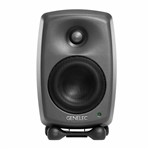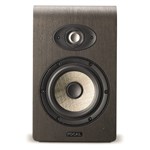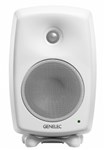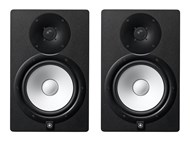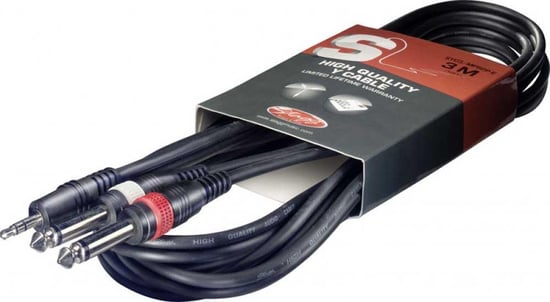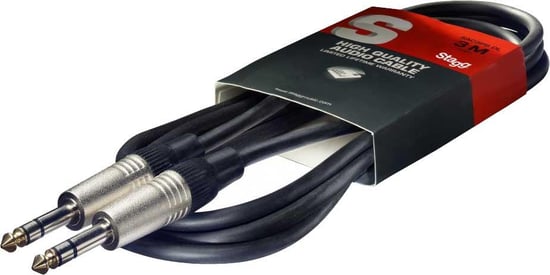Yamaha HS8 Active Studio Monitors with Stands, White Overview
The HS8 bundles comes with a pair of Adam Hall SKDB 039 Studio Monitor Stands
Overview by GAK
The new second-generation HS8 near-field reference monitors are amongst the top industry standard monitors for any studio.
The HS8 monitors feature the largest speaker cone out of the entire HS range and are the optimal choice if you require extended low-frequency response and range.
The HS range of active studio monitors come in either sleek Black or striking White, so you can pick the perfect pair to match your studio’s design.
If you’re starting to get serious about your mixes, the Yamaha HS series is by far and away one of the top choices. Whilst lesser speakers can inhibit the quality of your mix by enhancing the bass or colouring your music’s character in some way, the defining and most appealing quality of the HS Series is how accurately and precisely it represents your music.
Don’t mistake the honest nature of this range for inferior quality, the HS Series is renowned for its excellent signal reproduction, superior sound and high-performance. The fact that they are utilised in professional studios all over the world is a testament to this.
The HS8 range features an 8” cone woofer and 1” dome tweeter, 38Hz - 30kHz frequency response, 75W LF plus 45W HF bi-amp system, 70W power amplification, ROOM CONTROL and HIGH TRIM response controls, XLR and TRS phone jack inputs.
Low and midrange frequencies are tight and defined thanks to the 8-inch ultra-responsive woofer - don’t be fooled by its size! The 1-inch dome tweeter is responsible for the HS5’s glistening top-end. The HS range’s innovative bi-amped design features an individual amp for the woofer and the tweeter, which ensures high-definition sound. This technology combined with the flat-response of the HS Series means you have a speaker that sounds amazing with a clean and true tone.
The HS8’s state-of-the-art design eliminates undesirable resonant frequencies and reduces vibration, resulting in a pristine sound that is perfect for detailed mixing of complex arrangements. The sturdy MDF construction guarantees durability and boasts a damped acoustic response, with unwanted noise further reduced by the rear speaker port.
The HS range can adapt to any room environment thanks to a Level control located on the back as well as handy switches that let you adjust the high frequencies (High Trim) and reduce unnatural low frequencies if you place your monitors close to walls (Room Control).
The versatility of the HS Series is topped off by Yamaha’s inclusion of XLR and TRS jack which enable them to be used with a wide variety of sound sources such as interfaces, mixers and keys.
If you work in a smaller space where you don’t need to crank up your monitors to get the most out of them, the HS5 and HS7 variants may be better a choice for you - the HS Range caters to any room type and size thanks the different options of speaker size.
Overview by Yamaha
Yamaha Product Overview
The Yamaha HS5 is the second generation of ‘HS’ near-field reference monitors, like the models before them, share the same design philosophy and concepts as the industry standard and legendary NS-10M studio monitors. The Yamaha HS5 provide accurate signal reproduction and superior sound quality.
Ever since the 1970’s the iconic white woofer and signature sound of Yamaha’s near-field reference monitors have become a genuine industry standard for a reason—their accuracy.
Unlike studio monitors with added bass or treble frequencies which may sound more flattering at first, HS Series speakers were designed to give you the most honest, precise reference possible, providing an ideal sonic platform to build on throughout the mixing process. By combining acquired knowledge and expertise with state-of-the-art sound technologies, Yamaha’s speaker engineering team have examined, then optimised, every aspect that has contributed to making these monitors the most trusted in the business.
We recently sat down with one of our ProAudio specialists to go through some of our customers frequently asked questions. Here’s some of the feedback:
What inputs do the Yamaha HS8’s have on the rear panel?
The Yamaha HS series provides you with Male XLR and 1/4 TRS Jack inputs on the rear panel.
What makes the Yamaha HS8’s better than other Studio Monitors in this price range?
Well, the Yamaha HS series propels clarity to new, unheard-of levels. What they may lack in super-low-end, they make up for with a well-rounded, true replication of audio that translates/references better than monitors double the price.
What you get with the Yamaha HS series is the brand assurance that you’re using an established, high-performance and remarkably accurate monitoring system. Based on the NS10s (an industry standard), it’s a speaker that truly lives up to the overused line “if it sounds good on them, it will sound good on anything”.
How big are the Yamaha HS8’s?
Dimentions: 9.8 x 15.4 x 13.1" (250 x 390 x 334 mm)
Weight: 22.5 lb (10.2 kg)
How loud are the Yamaha HS8’s?
The Yamaha HS8’s features a 75W LF woofer and a 45W HF tweeter. Together, each speaker has a 120W output or 240W as a pair.
This is more than enough power to mix with and certainly enough to hold up a room full of your rowdy friends!
Will they suit a large studio?
Yes, the Yamaha HS8’s are ideal for large-sized commercial or home-based studios and deliver enough power to comfortably mix in any environment.
They can perform at a low volume comfortably, but perform better at a higher volume. This means they make a great monitor system for somewhere where volume can be appreciated, however, maybe a little overkill for smaller/compact home studios.
Can I use the HS8’s with my Phone?
Yes. All you need is the correct cable i.e. Dual Jack (for the back of speakers) to Minijack (phone), or Dual Male XLR (for the back of speakers) to Minijack (phone).
Enjoy hearing things like never before!
Do I need Acoustic foam (vibropads) for the Yamaha HS8s?
You do not need acoustic foam (vibropads), however, it is advised if you intend to place your speakers on a surface where vibrations may occur.
Acoustic foam helps to isolate the speakers so that there is little to no outside influence over their sound. The difference in performance can truly be astounding
Can I use the HS8’s for DJing?
Yes. The HS8’s work great as a DJ monitor because they provide enough output power and clarity to really get into it.
The bass extension on the HS8’s also comes in handy to really hone in on the bass and kick, beatmatching is hard as it is, it’s even harder when you can’t hear what you’re matching!
Are they available in different colours?
Yes. The Yamaha HS series also comes in white!
See HERE: https://www.gak.co.uk/en/yamaha-hs8-active-monitor-white-single/93145
What music genres do they suit best?
Much like the Yamaha HS’s ‘big brother’, the NS10s, the HS series can be used for all styles.
The unforgiving and uncomplimentary nature of these monitors makes them ideal for problem-finding and referencing. Unlike studio monitors with boosted bass or treble frequencies, which may sound more flattering at first, HS Series speakers were designed to give you the most honest, precise reference possible across all styles of music.
Having said this, my personal opinion is that the Yamahas truly shine on instrument-based music like Rock, Indie and Pop
What is the frequency range of the Yamaha HS8’s?
The HS7’s range from 38Hz to 30kHz.
The high-end control of these monitors is next to none at this price range and the bass extension on the larger models (HS7 & HS8) make the HS8’s a truly pleasurable listening experience.
What is Room Control and High Trim?
On the rear panel, you will find ROOM CONTROL and HIGH TRIM. These allow you to adjust the performance of your monitors to better suit your space.
Room Control is used to adjust the bass performance depending on how close your speakers are to the wall. 0 is no attenuation (reduction of amplitude). -2 and -4 attenuate the low end from 500hz down by either 2db or 4db. I recommend you find a song you know really well, then find which setting works best for your ears and space.
High Trim is used for boosting or cutting the HS5’s response 2dB above 2kHz, to adjust accordingly for a dull (boost) or live (cut) space.
Do I need a Subwoofer?
You do not need a Subwoofer with these monitors, however, it is advised if you want an extra level of control over the bass response.
The Yamaha HS8S Subwoofer is ideal for those of you who desire the signature flat-frequency character of Yamaha’s nearfield reference monitors, yet would like to hear more bass than is provided by just the HS monitors alone. This could be the case with bass-driven genres like Electronic music for instance.
See HERE: https://www.gak.co.uk/en/yamaha-hs8s-subwoofer/81955
Bass Extension with HS8S - 22Hz
Bass Extension without HS8S - 38Hz
Please note: Image for illustrative purposes only. Accessories subject to change without notice.
- A low resonance enclosure built using a three-way mitre-joint technique ensures that the corners of the speaker are firmly anchored leading to dramatically improved durability and the elimination of unwanted resonances that can colour the original sound. Yamaha's 'Vortex Sound Control' technology is deployed to decrease unwanted airflows around the speaker ports. This in turn reduces audible noise by up to 6dB.
- This speakers is a 2-way bass-reflew bi-amplified nearfield studio monitor with 8" cone woofer and 1" dome tweeter
- 38Hz - 30kHz frequency response
- 75W LF plus 45W HF bi-amped system (120W total)
- ROOM CONTROL and HIGH TRIM response controls
- XLR and TRS phone jack inputs - balanced or unbalanced
- Yamaha unveil the new Yamaha HS8 in white.
- The Yamaha HS8 is the second generation of 'HS' nearfield reference monitors, like the models before them, share the same design philosophy and concepts as the industry standard and legendary NS-10M studio monitors. The Yamaha HS8 provides accurate signal reproduction and superior sound quality.












